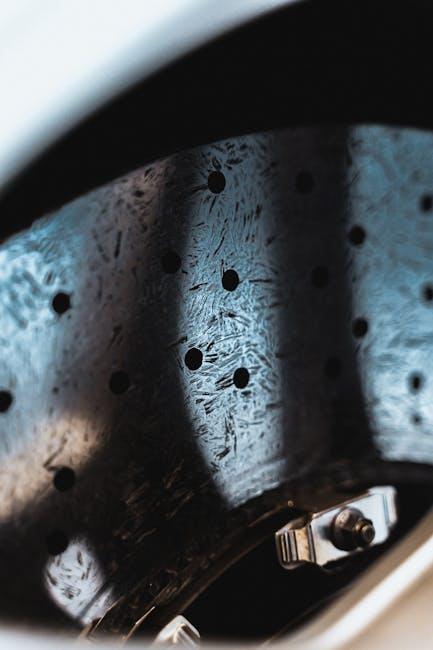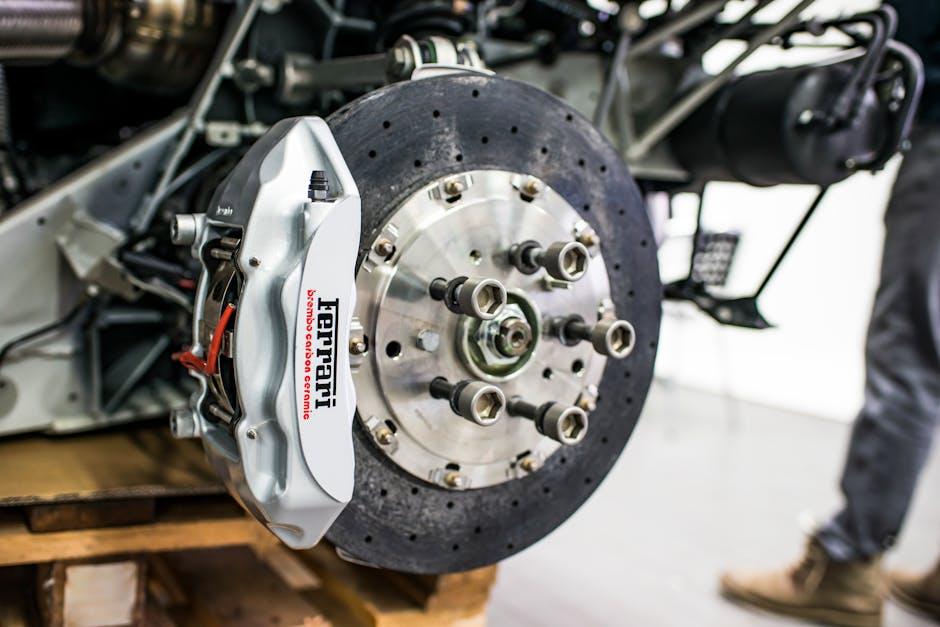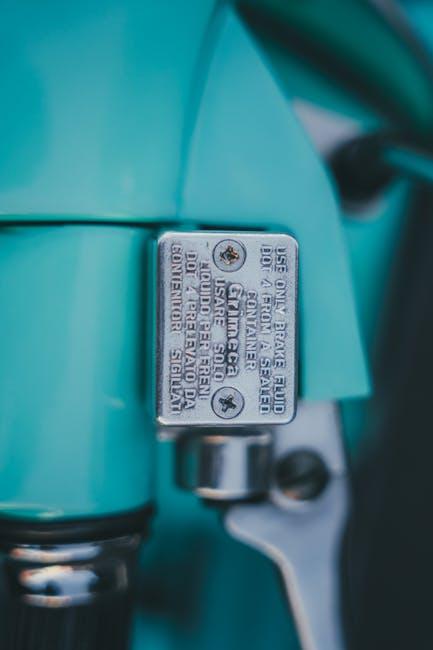Brakes are the unsung heroes of every journey, quietly working behind the scenes to keep us safe on the road. Yet, when this vital system begins to falter, the consequences can be swift and severe. Recognizing the subtle—and sometimes not so subtle—signs of a failing brake system is crucial for every driver. From unexpected noises to changes in pedal feel, these warning signals are your vehicle’s way of asking for help. In this article, we’ll explore the key indicators that your brakes might be on the brink of failure, empowering you to take action before it’s too late.
Table of Contents
- Signs Your Brake System is Warning You
- Unusual Noises and What They Reveal About Brake Wear
- How Brake Pedal Sensations Can Indicate Underlying Problems
- The Role of Brake Fluid and Its Impact on Performance
- Identifying Visible Brake Component Damage Early
- Preventive Maintenance Tips to Avoid Brake Failure
- Q&A
- Insights and Conclusions

Signs Your Brake System is Warning You
When your brake system begins to fail, it rarely happens without warning. Pay close attention to unusual sensations or sounds that might indicate trouble. Squealing or grinding noises when pressing the brake pedal often point to worn-out brake pads. Additionally, if your vehicle pulls to one side during braking, it may signal uneven brake wear or stuck calipers. Another subtle hint is a soft or spongy brake pedal, which could mean air in the brake lines or fluid leaks — both serious issues that demand prompt inspection.
- Vibrations or pulsations: A shaking brake pedal usually suggests warped rotors.
- Dashboard warning lights: Don’t ignore brake system alerts; they can underscore critical failures.
- Longer stopping distances: If your car takes more space to halt, the braking efficiency is compromised.
| Symptom | Possible Cause | Urgency Level |
|---|---|---|
| Squeaking Noise | Worn Brake Pads | Medium |
| Brake Pedal Feels Soft | Brake Fluid Leak | High |
| Vehicle Pulls to One Side | Uneven Pad Wear | Medium |
| ABS Warning Light | ABS System Fault | High |

Unusual Noises and What They Reveal About Brake Wear
When your brakes start to produce unexpected sounds, it’s more than just an annoyance—it’s your car’s way of signaling wear and potential danger. A high-pitched squeal typically suggests that the brake pads are nearing the end of their lifespan, triggering the built-in wear indicators to alert you. On the other hand, a grinding noise often reveals that the brake pads are completely worn down, causing the metal backing to scrape against the rotor. This metal-on-metal contact not only compromises braking efficiency but may also lead to expensive rotor damage if ignored.
Different noises can also hint at other brake system issues:
- Clicking or clunking: Loose or worn caliper components
- Rumbling or thumping: Warped rotors or uneven wear
- Whining or humming: Problems within the hydraulic system
| Noise Type | Likely Cause | Recommended Action |
|---|---|---|
| Squeal | Brake Pad Wear Indicator | Schedule brake pad replacement |
| Grinding | Metal Contact with Rotor | Immediate inspection and repair |
| Clicking | Loose Caliper Parts | Caliper adjustment or replacement |

How Brake Pedal Sensations Can Indicate Underlying Problems
When you press the brake pedal and notice unusual feelings beneath your foot, it’s a silent alarm signaling your braking system might be struggling. A spongy or soft pedal often suggests air trapped in the brake lines or low brake fluid levels, both of which diminish the hydraulic pressure essential for effective braking. Conversely, a hard or stiff pedal can indicate issues like a malfunctioning brake booster or blockages in the brake line, making it physically harder to slow down your vehicle. Recognizing these sensations early helps avoid sudden brake failure and costly repairs.
Sometimes, the pedal may pulsate or vibrate when applied, hinting at warped brake rotors or uneven wear on brake pads. Another critical warning is if the pedal slowly sinks toward the floor—this could be a sign of brake fluid leaks or failing master cylinders, compromising your ability to stop safely. Being attuned to these tactile warnings allows you to address the root cause before the problem escalates.
| Pedal Sensation | Possible Cause | Recommended Action |
|---|---|---|
| Spongy or Soft | Air in Brake Lines / Low Fluid | Bleed Brakes / Top Up Fluid |
| Hard or Stiff | Brake Booster Issue / Blockage | Inspect Brake Booster |
| Pulsating or Vibrating | Warped Rotors / Worn Pads | Replace Rotors / Pads |
| Pedal Sinks Slowly | Fluid Leak / Master Cylinder | Check for Leaks / Replace Cylinder |

The Role of Brake Fluid and Its Impact on Performance
Brake fluid is the unsung hero of your vehicle’s braking system, acting as the essential medium that transfers force from your foot on the pedal to the brake pads gripping the rotors. Over time, this fluid can absorb moisture from the air, leading to a decrease in its boiling point and reducing its overall efficiency. When brake fluid becomes contaminated or degrades, you may notice a spongy brake pedal or increased stopping distances, both of which are critical warning signs that the fluid is no longer performing optimally. Regular maintenance and timely replacement of brake fluid keep the entire system responsive and safe.
Recognizing how brake fluid impacts performance can help you avoid sudden brake failure. Here’s what to watch for:
- Soft or sinking pedal: Indicates fluid leakage or air bubbles due to degraded brake fluid.
- Reduced brake responsiveness: Caused by the lower boiling point of moisture-laden fluid under heavy braking.
- Unusual noises: Sometimes linked to improper fluid pressure impacting the brake components.
| Brake Fluid Property | Ideal Condition | Signs of Degradation |
|---|---|---|
| Boiling Point | 450°F (232°C) | Drops below 300°F (149°C) |
| Color | Clear or light amber | Dark brown or cloudy |
| Moisture Content | Less than 3% | Above 3%, increasing corrosion risk |

Identifying Visible Brake Component Damage Early
Keeping a keen eye on your brake components can save you time and money before problems escalate. Look closely for visual signs such as uneven wear on brake pads, which indicates misalignment or worn calipers. Rust or corrosion on the rotors not only affects performance but can also lead to cracking. Don’t overlook the brake lines; any cracks, leaks, or stiffened hoses are clear red flags that demand immediate attention.
Another subtle yet important indicator is the condition of the brake fluid reservoir. Cloudy or dark fluid points to contamination that compromises braking efficiency. Take note of these visible signs during routine checks:
- Brake pads thinner than 3mm
- Deep grooves or scoring on rotors
- Brake calipers leaking fluid
- Damaged or frayed brake lines
- Discolored or bubbly brake fluid
| Component | Visible Damage | Potential Consequence |
|---|---|---|
| Brake Pads | Severe thinning or cracks | Reduced stopping power |
| Brake Rotors | Rust, grooves, or warping | Vibration during braking |
| Brake Lines | Leaks or hardening | Brake fluid loss |
| Brake Fluid | Discoloration or bubbles | Loss of hydraulic pressure |

Preventive Maintenance Tips to Avoid Brake Failure
Regular upkeep is key to ensuring your braking system performs flawlessly when it matters most. Begin by checking the brake fluid level consistently—low fluid can signal leaks or worn-out components that require immediate attention. Alongside this, inspect brake pads for wear; thin or cracked pads not only reduce stopping power but can also damage rotors, leading to costly repairs. Riding the brakes or a soft, spongy pedal feel often indicates trapped air in lines or worn seals, both of which need professional servicing.
Integrating simple habits like flushing brake fluid every 2 years or 24,000 miles and scheduling a comprehensive brake inspection at least twice a year can reduce failure risks dramatically. Here’s a quick checklist to keep your brakes in top shape:
- Brake fluid level: Maintain between minimum and maximum marks;
- Pad thickness: Replace when less than 3mm;
- Rotor condition: Check for grooves or warping;
- Brake pedal feel: Ensure it is firm without excessive travel;
- Unusual noises: Address squealing or grinding immediately.
| Maintenance Task | Recommended Frequency | Signs to Watch For |
|---|---|---|
| Brake Fluid Replacement | Every 2 years | Soft pedal, sluggish response |
| Brake Pad Check | Every 10,000 miles | Thin pads, noise when braking |
| Brake System Inspection | Biannual | Vibrations, uneven braking |
Q&A
Q&A: Signs of a Failing Brake System
Q1: Why is it important to recognize the signs of a failing brake system early?
A1: Your brake system is the frontline guardian of your safety on the road. Detecting early warning signs helps prevent accidents, costly repairs, and complete brake failure. Timely attention ensures your vehicle stops reliably when you need it most.
Q2: What are the most common auditory signs that indicate brake trouble?
A2: Squealing, grinding, or squeaking noises when applying the brakes often signal worn brake pads or other brake component issues. These sounds act like a distress call from your brakes, urging you to inspect them before the problem escalates.
Q3: How does a soft or spongy brake pedal feel, and what does it mean?
A3: If your brake pedal feels unusually soft, mushy, or sinks to the floor with minimal resistance, it may indicate air in the brake lines, fluid leaks, or worn brake parts. This compromised pedal feel means your brakes might not respond effectively.
Q4: Can vibrations during braking suggest brake system problems?
A4: Absolutely. If you experience shaking or pulsation through the brake pedal or steering wheel while braking, it often points to warped brake rotors or uneven brake pad wear. Such vibrations should never be ignored.
Q5: What role does the brake warning light play in identifying brake system issues?
A5: The brake warning light on your dashboard is a direct communicator of trouble. It may light up due to low brake fluid, worn brake pads, or problems with the anti-lock braking system (ABS). Responding immediately to this alert can prevent further damage.
Q6: Are there any visual clues that your brake system is failing?
A6: Yes; if you notice brake fluid leaking near the wheels, corroded brake lines, or uneven brake pad wear when inspecting your wheels, these are clear visual signs that your brake system needs professional attention.
Q7: What happens if I ignore these signs and continue to drive?
A7: Ignoring brake system warnings can lead to reduced stopping power, longer stopping distances, or total brake failure—turning your vehicle into a dangerous hazard for you and others on the road. It’s a risk that’s simply not worth taking.
Q8: How often should I have my brakes inspected to catch these signs early?
A8: Routine brake inspections every 10,000 to 15,000 miles, or during regular vehicle maintenance, are recommended. However, if you notice any of the above signs, seek an immediate professional evaluation regardless of mileage.
Q9: Can weather conditions influence how quickly brake problems develop?
A9: Yes. Moisture, salt, and extreme temperatures can accelerate brake wear and corrosion, making you more susceptible to brake issues. Regular check-ups are especially important in harsh climates.
Q10: What is the best course of action if I suspect my brake system is failing?
A10: Don’t hesitate—schedule a professional brake inspection as soon as possible. Prompt repairs or part replacements not only restore your vehicle’s safety but also save money in the long run by preventing further damage.
Recognizing the subtle whispers and loud alarms of your brake system can make the difference between a safe journey and a dangerous ordeal. Stay alert, and keep your brakes—and yourself—steady on the road.
Insights and Conclusions
Recognizing the signs of a failing brake system is not just about preserving your vehicle—it’s about protecting what matters most: your safety and those around you. By staying alert to unusual noises, diminished responsiveness, or warning lights, you empower yourself to take timely action before small issues turn into serious hazards. Remember, brakes are your car’s most vital communication with the road—listen closely, and when in doubt, don’t hesitate to seek professional care. Your peace of mind, and the smooth stop of every journey, depend on it.
